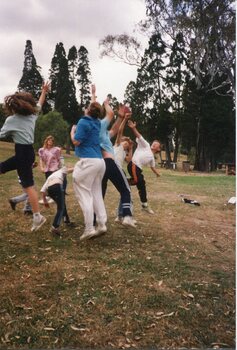Historical information
This photograph, likely taken during Jacana Primary School’s 1990 Christmas picnic at Greenvale Reservoir, captures a dynamic moment of childhood play and joy. A group of children is seen mid-jump in a grassy park surrounded by tall trees, their movement and energy reflecting the carefree spirit of the occasion. The image offers a vivid snapshot of outdoor recreational activities that were central to the school’s end-of-year celebrations.
Jacana Primary School, established in 1959 and closed in the early 2000s, was a vital institution in Melbourne’s northern suburbs. Known for its strong emphasis on both academic and social development, the school fostered a culture of inclusivity and community engagement. Events like the annual Christmas picnic were more than festive gatherings—they were opportunities for students, staff, and families to connect, celebrate, and reinforce the school’s values in a relaxed, natural setting.
This photograph is historically significant as it documents the lived experiences of students during a period when outdoor play and communal events were integral to primary education. It reflects broader educational practices of the time, where physical activity, social interaction, and connection to nature were seen as essential components of a well-rounded schooling experience.
Significance
This photograph is a culturally and historically significant record of Jacana Primary School’s community life in the late 20th century. Captured during the 1990 Christmas picnic—likely held at Greenvale Reservoir—it depicts a group of children mid-jump in a moment of spontaneous outdoor play. The image embodies the spirit of joy, freedom, and social connection that characterised the school’s end-of-year celebrations.
Jacana Primary School, which operated from 1959 until the early 2000s, was a cornerstone of Melbourne’s northern suburbs, known for its commitment to inclusive education and community engagement. Events such as the annual picnic were integral to the school’s ethos, reinforcing bonds between students, staff, and families in informal, nature-based settings.
The photograph is significant not only as a visual document of a specific event but also as a broader representation of educational values of the time—emphasising physical activity, social development, and the importance of shared experiences. It contributes to the historical narrative of public schooling in Victoria and preserves the memory of a school community that played a formative role in the lives of many local families.
Physical description
Colour Photograph on glossy paper in portrait format
Inscriptions & markings
PH18289 (crossed out)
PH-4209 (crossed out)
PH-4868/this paper/manufactured/by Kodak

